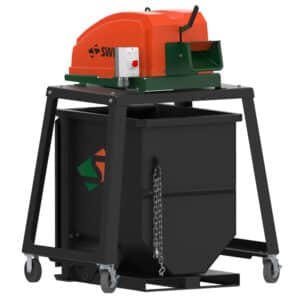Problem Solvers: Ed’s Pallet World Chops Blades Down to Size with Help from Sweed Scrap Chopper
Written by Lisa Monroe, Pallet Enterprise Magazine
Problem: Saw blades that have been removed from machinery to be replaced take up valuable facility space and also pose cutting risks the more they are handled.
Like a lot of pallet businesses, just about everything at Ed’s Pallet World is recycled, from wood waste to shrink wrap. Saw blades are no different.
In North Carolina, where the company’s main 17,000-square-foot pallet manufacturing facility is located, you can’t throw any wood waste in the landfills, said Mark Galloway, the company’s salesman.
Ed’s Pallet World, which manufactures approximately 20,000 pallets per week between new pallets, repaired pallets and recycled pallets, is proud of its recycling efforts. It only produces one small dumpster of garbage per week. And it’s machinery like the Sweed Scrap Chopper Model 450 that makes the recycling efforts efficient.
The chopper is used at Ed’s to chop up all the large steel blades that come off the company’s band saw dismantler and its five-head Brewer resaw. The chopper reduces the blades to small pieces that drop into the 55-gallon drum that sits underneath it. All the guys at Ed’s have to do is take the barrel to a recycling plant every 2-3 months.
With the large volume of pallets Ed’s manufacturers, it obviously goes through a lot of blades, as they become dull or wear out. About 15-20 blades per week on the resaw and at least one blade per day on the dismantler have to be replaced.
“These blades are a bit unwieldy to handle, and even though they are dull, they are still jagged and sharp enough to cut you,” said Galloway. Workers actually snap the resaw blades in half to make them easier to handle.
“We could put them in bins, but the more times they are handled, the more opportunities there are to get cut,” he said. That’s why the blades are handled as little as possible by workers and moved to the chopper quickly to be reduced to manageable sized waste for recycling.
How does the Sweed chopper hold up? “It’s a very sturdy well built industrial quality machine. It does have knife blocks that do need to be replaced, but they seem to last forever.”
Galloway said Ed’s has only ordered two sets of blades in the five years he’s been with the company, and the machine was there when he came on board.
“As far as other maintenance, it has no problem with tearing up or breaking down. With a little bit of routine maintenance, that thing does its job,” he said.
While Ed’s primarily uses its chopper to reduce saw blades, a lot of pallet companies also use them for reducing metal bands and polyethylene (PET) straps that are wrapped around lumber when its delivered, said Melissa Tally of Sweed. Most of the metal bands are ½-inch steel, are super sharp, and can cut employees, making them a danger to handle. Both steel and plastic strapping can cause a bird’s nest of material in bins or in the garbage once lumber has been de-banded which takes up a lot of space. This makes it expensive to store and dispose of because a dumpster full of un-compacted strapping is mostly air.
Sweed Scrap Choppers compact the scrap and eliminate the need for costly disposal fees, and since the scrap is compacted, most scrap dealers will either pay the customer for their ready-to-recycle scrap, or pick it up for free, Tally explained.
She said Sweed’s Model 450 DDX is the most popular model for PET straps while pallet companies that produce high-volumes of steel banding or bandsaw blades often go with the Model 510 XHD.


